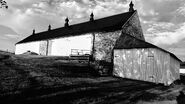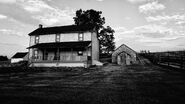| Antietam National Battlefield | |
IUCN Category V (Protected Landscape/Seascape) | |
| A photo of Bloody Lane. A photo of Bloody Lane. | |
| Location | Washington County, Maryland, USA |
|---|---|
| Nearest city | Sharpsburg, MD |
| Coordinates | 39°28′N 77°44′W / 39.47°N 77.74°WCoordinates: 39°28′N 77°44′W / 39.47°N 77.74°W |
| Area | 3,255.89 acres (13.18 km2) 2,725.01 acres (11.03 km2) federal |
| Established | August 30, 1890 |
| Visitors | 337,569 (in 2007) |
| Governing body | National Park Service |
Antietam National Battlefield is a National Park Service protected area along Antietam Creek in Sharpsburg, Maryland which commemorates the American Civil War Battle of Antietam that occurred on September 17, 1862. The area, situated on fields among the Appalachian foothills near the Potomac River, features the battlefield site and visitor center, a national military cemetery and a field hospital museum. Today, over 330,000 people visit the park each year.
Battlefield[]
In the Battle of Antietam, General Robert E. Lee's first invasion of the North ended on this battlefield in 1862.[1]
Established as Antietam National Battlefield Site August 30, 1890,[2] the park was transferred from the War Department August 10, 1933,[3] and redesignated November 10, 1978.[2] Along with all historic areas administered by the National Park Service, the battlefield was listed on the National Register of Historic Places on October 15, 1966.[4] Additional documentation on the site was recorded by the National Park Service on February 27, 2009.[5]
Cemetery[]
Monument in the Antietam National Cemetery
Antietam National Cemetery, whose 11.36 acres (46,000 m2) contain 5,032 interments (1,836 unidentified), adjoins the park. Civil War interments occurred in 1866. The cemetery contains only Union soldiers from the Civil War period. Confederate dead were interred in the Washington Confederate Cemetery within Rosehill Cemetery, Hagerstown, Maryland; Mt. Olivet Cemetery in Frederick, Maryland; and Elmwood Cemetery in Shepherdstown, West Virginia.[6] The cemetery also contains the graves of veterans and their wives from the Spanish-American War, World War I and II, and the Korean War. The cemetery was closed to additional interments in 1953. An exception was made in 2000 for the remains of USN Fireman Patrick Howard Roy who was killed in the attack on the USS Cole.[7] The Antietam National Cemetery was placed under the War Department on July 14, 1870;[8] it was transferred to the National Park Service on August 10, 1933.[9]
Visitor Center[]
Burnside's Bridge
The Antietam National Battlefield Visitor Center contains museum exhibits about the battle and the Civil War. The movie "Antietam Visit" depicts the battle and President Abraham Lincoln's visit to Union Commander General George B. McClellan. A documentary about the battle is also shown. Park rangers offer interpretive talks. An audio tour is available for purchase to accompany the self-guided 8.5-mile (13.7 km) driving tour of the battlefield with eleven stops.
The Visitor Center was constructed in 1962 as part of the Mission 66 plan. It is being considered for replacement with a visitor center that is more keeping with the historic nature of the Battlefield.[10]
Pry House Field Hospital Museum[]
The Pry House Field Hospital Museum is located in the house that served as Union Commander General George B. McClellan's headquarters during the battle. Exhibits focus on period medical care of the wounded, as well as information about the Pry House. The museum is sponsored by the National Museum of Civil War Medicine.
The battle[]
Morning phase[]
Dunker Church
The Battle began at dawn on September 17, 1862, when Maj. Gen. Joseph Hooker began the Union artillery bombardment off the Confederate positions of Maj. Gen. Thomas J. "Stonewall" Jackson positions in the Miller cornfield. Hooker's troops advanced behind the falling shells and drove the Confederates from their positions. Around 7 a.m. Jackson reinforced his troops and pushed the Union troops back. Union Maj. Gen. Joseph K. Mansfield sent his men into the fray and regained some of the ground lost to the Confederates.[11]
Mid-day phase[]
Sunken Road.
As the fighting in the cornfield was coming to a close, Maj. Gen. William H. French was moving his Federals forward to support Maj. Gen. John Sedgwick and veered into Confederate Maj. Gen. D.H. Hill's troops posted in the Sunken Road. Fierce fighting continued here for four hours before exhaustion overwhelmed both sides.[11]
Afternoon phase[]
Union positions below the Confederates at Burnside Bridge
On the southeast side of town, Union Maj. Gen. Ambrose E. Burnside's troops had been trying to cross Antietam Creek since mid-morning. Around 1 p.m., they finally cross the bridge and took the heights. After a 2 hour lull to reform the Union lines, they advanced up the hill, driving the Confederates back towards Sharpsburg. But for the timely arrival of Maj. Gen. A.P. Hill's division from Harpers Ferry, Burnside would have entered Sharpsburg. Instead, the Union troops were driven back to the heights above the bridge.[11]
Conclusion[]
The battle was over with the Union sitting on three sides, waiting for the next day. During the night, General Lee pulled his troops back across the Potomac River, leaving the battle and the town to General McClellan.
References[]
- The National Parks: Index 2001-2003. Washington: U.S. Department of the Interior.
Notes[]
- ↑ Tilberg, Frederick (1960). "Across the Potomac". Antietam National Battlefield Site Maryland Historical Handbook. National Park Service. http://www.cr.nps.gov/history/online_books/hh/31/hh31a.htm. Retrieved February 2, 2007.
- ↑ 2.0 2.1 "National Park System Birthdays". National Park Service History. National Park Service. April 13, 2006. http://www.cr.nps.gov/history/hisnps/NPSHistory/birthdays.htm. Retrieved February 2, 2007.
- ↑ Tilberg, Frederick (1960). "Antietam National Battlefield Site and Cemetery". Antietam National Battlefield Site Maryland Historical Handbook. National Park Service. http://www.cr.nps.gov/history/online_books/hh/31/hh31t.htm. Retrieved February 2, 2007.
- ↑ "Antietam National Battlefield Query". National Register Information System. National Register of Historic Places. http://www.nr.nps.gov/iwisapi/explorer.dll?IWS_SCHEMA=NRIS1&IWS_LOGIN=1&IWS_REPORT=100000044. Retrieved February 2, 2007.
- ↑ "WEEKLY LIST OF ACTIONS TAKEN ON PROPERTIES: 2/23/09 THROUGH 2/27/09". National Register of Historic Places. National Park Service. 2009-03-06. http://www.nps.gov/history/nr/listings/20090306.HTM.
- ↑ "Antietam National Cemetery". National Park Service. July 25, 2006. http://www.nps.gov/anti/historyculture/antietam-national-cemetery.htm. Retrieved February 2, 2007.
- ↑ "Antietam National Cemetery, part 2". National Park Service. http://www.nps.gov/anti/historyculture/antietam-national-cemetery-part-2.htm. Retrieved February 2, 2007.
- ↑ Lee, Ronald F. (1973). "III. The First Battlefield Parks,1890-1899". The Origin and Evolution of the National Military Park Idea. National Park Service. http://www.cr.nps.gov/history/online_books/history_military/nmpidea5d.htm. Retrieved February 2, 2007.
- ↑ "1930 through 1939". NPS Chronological Timeline. National Park Service. May 19, 2006. http://home.nps.gov/applications/budget2/NPS1930.html. Retrieved February 2, 2007.
- ↑ French, C. Madrid. "Visitor Centers at the National Parks". Mission66.com. http://www.mission66.com/centers.html. Retrieved 2009-03-11.
- ↑ 11.0 11.1 11.2 Antietam National Battlefield, Maryland Brochure; National Park Service, U.S. Department of the Interior; Harpers Ferry Design Center, Harpers Ferry, WV
External links[]
- Official NPS website: Antietam National Battlefield
- Antietam National Cemetery
- Image archive from NPS
- 28 photos of Antietam National Cemetery: "Sites of Memory"
- History of Antietam National Cemetery, including a descriptive list of all the loyal soldiers buried therein together with the ceremonies and address on the occasion of the dedication of the grounds, September, 17th, 1867, Antietam National Cemetery, Western Maryland Regional Library
| ||||||||||||||||||||||||||||||||||||||||||||
| ||||||||||||||||||||||
sv:Antietam National Battlefield


